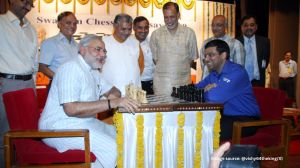How one man with a red flag averted disaster on the tracks
One man and his little red flag today made all the difference between a rail accident and a Rajdhani-like tragedy: Rudal Manjhi, a 44-year-o...

One man and his little red flag today made all the difference between a rail accident and a Rajdhani-like tragedy: Rudal Manjhi, a 44-year-old Indian Railways gateman.
Manjhi was on duty on Gate No 33C at Rewari Bhola four kms from Chapra, and his presence of mind considerably lessened the impact of the collision between the 5224 Gwalior-Barauni Express and the stationary 5210 Amritsar-Barauni Jan Seva Express this morning, preventing a repeat of the Howrah-New Delhi Rajdhani derailment in Rafiganj in September.
The engine of the Gwalior Express rammed into the stationary Jan Seva Express at 8.30 a.m. today a few yards away from Manjhi’s gate between Kopasamhauta and Tekniwas stations on the Chapra-Siwan section.
| The site of Tuesday’s train collision near Chapra. PTI |
The impact could have been far, far worse had Manjhi not leapt onto the track and charged towards the Gwalior Express even as it hurtled in his direction, madly waving his red flag.
One passenger, Ram Dular Paswan from Madhubani district, was killed, three others were seriously injured—one passenger’s legs had to be amputated—and 21 sustained minor injuries.
According to Manjhi—he was on duty despite having completed his 12-hour shift at 6 a.m. because his replacement hadn’t showed up—the Jan Seva Express came to a grinding halt two yards away from his gate.
‘‘I asked the guard what was wrong. He in turn asked the driver, who said that the vacuum (a rubber contraption between two bogeys) was probably missing. The guard went off to check. I then realised that it was time for the Gwalior Express to pass through.’’
Manjhi could already see the train in the distance, travelling at a speed of 80 km per hour. ‘‘I tried to tie the red flag on to the bamboo stick, but when I couldn’t, I ran towards the train on the track, waving the red flag.’’
As the train neared, Manjhi had to leap off the track, hurting his legs in the process. ‘‘The gateman rushed towards the speeding train and managed to slow it down. Otherwise, the accident would have been more severe,’’ said Superintendent of Police, Saran, Kundan Krishan. The driver and assistant driver of the Gwalior Express fled immediately after the accident.
The loco inspector has been suspended.
‘‘An inquiry is on, but initial findings show that the accident took place because of human failure or because the signal at one of the gates wasn’t working properly. It could be that the driver did not obey the signal,’’ the Varanasi DRM, C P Verma, told The Indian Express.
Preliminary findings also suggest that the Jan Sewa train stopped because of chain pulling.
Either way, Verma admitted, the Railways was at fault. His views were echoed by minister Nitish Kumar, who said in New Delhi that ‘‘this (accident) has nothing to do with the state of Bihar. It is purely related to the Railways. It happened at 8.15 a.m. and we need to determine the cause.’’
What neither the Railway minister nor any official were talking about yet: a reward for Manjhi’s flag-waving heroism. Manjhi himself is self-effacing, and said that he was only doing his job.
‘‘It was my duty. I haven’t done anything beyond that,’’ he said back home in his village, which is just half a km away from his gate. His wife Gayanti Devi fainted when she saw him being carried into the house, and she’s now pleading with Manjhi—they have four children—not to return to work.
Manjhi will have none of it. He’s been manning the same gate for the past 11 years, and he said that as soon as his legs heal, he will be back on the job. Perhaps saving some more lives in the bargain.
Photos



- 01
- 02
- 03
- 04
- 05




























